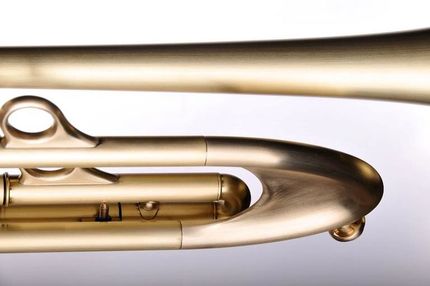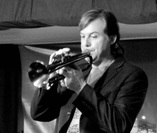 I receive more questions about the "brushed brass" finish on my trumpets and accessories than I would expect. In the twenty years I have been brushing brass, I have likely answered these questions thousands of times so here's an explanation for everyone. Machining and metal fabrication involves cutting, grinding, bending, shaping, stretching, heating and even hammering. These processes leave the brass looking very abused as if it was left out in the elements for a hundred years. So we have to clean it up by removing the oxidized outer layer. I have a very specific set of techniques to achieve a raw brass finish and highly recommend the "brushed brass" version over polished for good reasons. Polishing brass before lacquer or plating requires a mirror finish that is only attainable by removing a large amount of material. Since the fabricated brass is somewhat porous from bending and stretching, the material above the pores must be buffed off with rags and wheels using an abrasive compound. This can easily remove 20% of the material. Buffing is also prone to human error as the more difficult spots to hit become targets. Like hitting the bulls eye in darts, buffing usually hits around the target more than the center creating inconsistent wall thickness throughout most of the horn. This is usually the result of hard to reach areas like under a brace or inside a curve and an ultrasonic thickness gauge reveals the damage. We hand brush every instrument and accessory including mouthpieces to prevent deformation of the original design. By doing so, the small porous surface still exists to some extent, but is blended by the reflective micro-lines left from our work. Plating and lacquer may be applied over the brushed brass finish as a personal preference, but this is not necessary. Leaving a horn in raw "brushed brass" will allow it to tarnish and patina to some combination of a brown, green, orange and purple hue. You my consider a leather valve guard to protect your skin from coming in contact with brass over long periods of time and the original finish may be maintained with regular applications of Carnauba wax. The advantages of brushing brass over polishing include:
 "Isn't silver brighter than brass?" This topic leads to many other questions regarding the nature of raw brass instruments. There is a common misconception that a brass instrument plays darker or different than a silver plated instrument. However, with all other factors being equal, a silver plated horn plays no different than one unfinished in the raw brass state. Silver plating is not thick enough to change anything perceptible. Rumors vs. Facts I have tested this theory in the lab and I suspect that this rumor originated from people not comparing apples to apples. My guess is that Player A (raw brass horn) sounded darker than Player B (silver plated horn) and other Players deducted that the finish was the only difference when in reality there were other unknown factors present. Think about it, the guy playing the raw brass horn is more likely to be experimenting with other variables regardless if they were ever mentioned. How has this myth managed to continue for generations? Most likely because trumpet players like to think they have a grasp on how things work regardless of where they gained their knowledge. Reading something on the internet and then repeating it is the greatest source of person to person spread of misinformation. How can you verify that what you are reading in my blog today is in fact true? Schedule some time in an acoustics lab and measure the sound spectrum before and after silver plating an original raw brass horn. By the way, you do not want to measure a silver horn and then compare it after stripping it down to raw brass as you will likely create other variables in the stripping process. "What makes a horn darker?" When you compare two similar horns and determine that one is darker than the other, there must be a difference between them. I specialize in designing and building horns that meet specific client requirements. When someone asks for a Bb trumpet to sound darker than a Bach 72 while being more focused than a Martin Handcraft Committee, I offer them various options based on acoustics principles. I have spent my entire career listening to my clients compare leadpipes and bells combining, that feedback with the physical definitions of all components. No two leadpipe and bell configurations play or sound the same. This means there is in fact a logical way to distinguish between two horns that look the same, but sound different. It also means there is an amazing world of colors and attributes available to be explored. If you have played a few different brands of horns and haven't experienced much difference, you are missing out on some serious fun! Some of the potential differences between two seemingly similar horns include: Venturi - the inside diameter of the leadpipe, which varies greatly within some very popular brands Gap/Impedance - this is a huge topic so check out my blog for a full explanation Leadpipe Length - believe it or not, some companies install leadpipes with unintentional length variations Tuning Slide Variance - common in bent tubes from every manufacturer, pinched bore size inside slides (manufacturing flaw) Solder blockage - need I say more? I have removed solder from almost every Bach Strad that has come through my shop Mislabeling - this is a widespread problem that I have verified in most brands with the exception of Yamaha Which finish is the most efficient? Surprisingly to many players, lacquer finishes are usually more efficient and stable throughout all registers. A high quality lacquer will add enough thickness and strength to the instrument wall to actually make it a better playing horn. Again, you may verify this with your own experiments. Although this should come as no surprise to those in the aerospace industry as specialty coating are often times the key to ensuring stable predictable flight characteristics in planes, helicopters, atmospheric re-entry vehicles, missiles and even bullets. If this is of interest to you, consider studying carbon and Kevlar fiber fabrication, which relies almost entirely on the resin which hardens fabric to the desired shape.
7 Comments
Greg Zent
1/28/2014 04:04:57 am
Excellent article!
Reply
4/1/2014 03:15:07 am
Jason, you have cleared up many misconceptions here that I have always wondered about. I always thought myself that silver and gold plating do not significantly change a horns sound. I slight change in mouthpiece would definitely have more impact! Thanks for your logic and clarity!
Reply
4/27/2015 05:25:22 am
Hello Mr. Harrelson
Reply
Hello Joel,
Reply
Charlie
3/2/2018 11:52:08 am
I understand how in aerospace we coat layers onto structural materials and elements to provide flow characteristics and durability etc, however these are external and the acting flow is also external (air to a wing)
Reply
Chris Carranza
7/17/2018 02:51:01 am
How does the weight affects the sound of a trumpet? Is adding weight somehow makes the trumpet sound darker?
Reply
Your comment will be posted after it is approved.
Leave a Reply. |
Jason Harrelson
Inventor, Musician, Educator and Founder of Harrelson Trumpets, Trumpet Momentum and Harrelson Momentum. Archives
July 2024
|


 RSS Feed
RSS Feed
